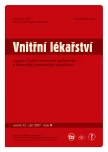Long-term monitoring of patients with clinical symptoms of upper gastrointestinal tract bleeding with a negative endoscopy result
Authors:
E. Machytka 1
; J. Ehrmann 2; P. Svoboda 1; P. Klvaňa 1; Arnošt Martínek 1
; P. Vávra 3
Authors‘ workplace:
Interní klinika FNsP Ostrava-Poruba, přednosta doc. MUDr. Arnošt Martínek, CSc.
1; II. interní klinika Lékařské fakulty UP a FN Olomouc, přednosta doc. MUDr. Vlastimil Procházka, Ph. D.
2; Chirurgická klinika FNsP Ostrava-Poruba, přednosta doc. MUDr. Jan Dostalík, CSc.
3
Published in:
Vnitř Lék 2007; 53(9): 942-946
Category:
Original Contributions
Overview
The authors present the results of a long-term monitoring of patients who presented with clinical signs of bleeding from the upper gastrointestinal tract (GIT) but totally negative endoscopy results on admission. Retrospective-prospective analysis of acute endoscopies in patients with clinical signs of bleeding from the upper gastrointestinal tract performed in the Endoscopy Centre of the Ostrava Teaching Hospital from 2002 to 2005, long term monitoring of the sample with negative results on admission. A total of 133 patients, i.e. 16.3 % of all acute procedures, with no source of bleeding detected in the first endoscopy. 26.4 % of wrong indications. In the rest of the sample, a source of bleeding was detected by endoscopy in 17 patients (15 in an early examination and 2 within one month from the event), i.e. 17.3 %. The rate of bleeding recurrence was 15 %. The risk of recurrence was higher in patients with haematemesis and a decrease in the blood count (BC) at the time of the first event. In 19 patients, i.e. 14.3 %, the source was not detected. In the remaining 33 patients, the findings were as follows: 1) in 4 patients, the source of bleeding was detected in the small intestine (push enteroscopy or enteroclysis); 2) in 3 patients, the source of bleeding was detected in the colon; 3) in 6 patients, IBD was detected; 4) in 5 patients, cirrhosis of the liver was diagnosed within months or years from the event.
Key words:
gastrointestinal bleeding – negative finding
Sources
1. Mařatka Z. Gastroenterologie. Praha: Karolinum 1999; 435-446.
2. Mařatka Z. Urgentní endoskopie při hematemeze a meleně. In: Fibroskopie trávicí trubice. Praha: Avicenum 1984.
3. Zavoral M, Dítě P, Špičák J et al. Endoskopická léčba krvácení do trávicího ústrojí - srovnání jednotlivých technik. In: Nové trendy v digestivní endoskopické diagnostice a léčbě. Praha: Grada Publishing 2000.
4. Dítě P et al. Akutní nevarikózní krvácení do horní části trávicího ústrojí. In: Akutní stavy v gastroenterologii. Praha: Galén 2005.
5. Konečný M, Ehrmann J, Procházka V et al. Naše zkušenosti s novou organizací péče o nemocné s akutním krvácením do horní části trávicího traktu. Vnitř Lék 2005; 51: 36-40.
6. Yamada T et al. Textbook of Gastroenterology. Philadeplhia: LWW 1999.
7. Zaltman C, de Souza H, Castro M et al. Upper gastrointestinal bleeding in a Brazilian hospital: a resprospective study of endoscopic records. Arq Gastroenterol 2002; 39: 74-80.
8. Thomopoulos KC, Theocharis GJ, Nikolopoulou VN et al. Acute upper gastrointestinal bleeding in patients on long-term oral anticoagulation therapy: Endoscopic findings, clinical management and outcome. World J Gastroenterol 2005; 11: 1365-1368.
9. Goláňová J, Hrdlička L, Šťovíček J et al. Akutní krvácení z horní části gastrointestinálního traktu - přehled urgentních endoskopií horní části trávicího traktu na našem pracovišti. Vnitř Lék 2004; 50: 274-277.
10. Suchánek Š, Stefanová M, Závada F et al. Urgentní endoskopie při krvácení do horní části trávicího traktu za rok 2005. HPB Bulletin 2006; 52-54.
11. Třeška V, Geiger J, Šebor J et al. Krvácení do gatrointestinálního traktu - zkušenosti Chirurgické kliniky FN v Plzni. HPB Bulletin 2006; 41-43.
12. Rockall TA, Logan RFA, Devlin HB et al. Incidence of and mortality from acute upper gastrointestinal haemorrhage in the United Kingdom. BMJ 1995; 311: 222-226.
13. Ameciran Gastroenterological Association Medical Positron Statement: Evaluation and Management of Occult and Obscure Gastrointestinal Bleeding. Gastroenterology 2000; 118: 197-200.
14. Zuckermann G, Prakash C, Askin M et al. AGA technical review on the evaluation and management of occult and obscure bleeding. Gastroenterology 2000; 118: 201-221.
15. Descamps C, Schmit A, Van Gossum A. Missed upper gastrointestinal tract lesions may explain occult bleeding. Endoscopy 1999; 31: 452-455.
16. Hayat M, Axon A, O´Mahony S. Diagnostic yield and effect on clinical outcomes of push enteroscopy in suspected small bowel bleeding. Endoscopy 2000; 32: 369-372.
17. Zonča P, Malý T, Vávra P. Skórovací systémy při krvácení z horního trávicího ústrojí. Čes Slov Gastroent 2000; 54(Suppl. 1): 84.
Labels
Diabetology Endocrinology Internal medicineArticle was published in
Internal Medicine

2007 Issue 9
Most read in this issue
- Intraabdominal hypertension at intensive care units
- Primary aldosteronism
- Chronic fatigue syndrome in cancer patients. Diagnostic and treatment options.
- Early haemodynamic changes after radiofrequency ablation of the atrioventricular junction
